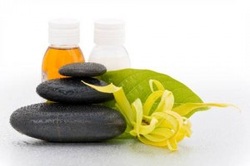
One of the great features of using essential oils therapeutically is the ease with which they get into our cells and our bloodstream. Because of their lipophillic (fat-friendly) nature, essential oils pass through cell membranes, and make their way throughout our bodies when inhaled or used topically. When you put essential oils on your throat, they pass through your skin to the lymph nodes in your neck. When inhaled, diffused essential oils penetrate the cells of your respiratory system, in the nose, sinuses, throat, bronchial tubes, and lungs.
A search of pubmed.gov returns pages and pages of peer-reviewed studies, demonstrating the efficacy of essential oils as antiviral agents. A number of essential oils have been shown to have antiviral activity, and these essential oils are rich in a class of molecules called monoterpines. Linalool, the sweet note in Lavender and a great many other oils is a monoterpine, which is effective in inactivating enveloped viruses (the virus which causes the flue each year is an enveloped virus.) Researchers have found that essential oils inactivate viruses in one of two ways: by inhibiting their ability to replicate and/or inhibiting viruses’ ability to fuse to cell walls and infect a host cell. What’s important to us here is that the oils act directly on the viruses themselves. Many oils have also been shown to positively support our own immune system, enhancing its ability to ward off infecting microbes - essential oils thus provide two independent means of warding off illness from viral infection.
Another important discovery is that whole, natural essential oils are 10 times more effective in inactivating viruses than individual, isolated compounds from these oils. that is to say, Tea Tree essential oil is approximately 10 times more effective than terpinen-4-ol alone the compound in Tea Tree thought to be the most active antiviral constituent). This has been the case for each oil studied, and has been shown to be true when essential oils have been researched for their antibacterial properties as well.
To keep well during the cooler months, when a cold, flu, or stomach viruses may be going around, we diffuse and topically apply our Legends Blend, along with Tea Tree, Lavender, and Lemon Grass. We mix a few drops of Lemon Grass, Lemon, Lavender, Tea Tree, and a few drops of Legends Blend in a spray bottle of water and use this to disinfect and clean counters, faucets, door knobs, etc. to kill germs and sanitize. There is no single essential oil that is most effective against all viruses, so we blend several highly active antiviral essential oils together to provide us with the most effective broad-spectrum formula.
By inhaling these essential oils from a diffuser, we can get an active amount of these essential oils throughout our respiratory system, and even in our bloodstream. The effect we’ve noticed is that we rarely catch colds when they are going around our community. We had company just recently spend a few days with us, and the day after she arrived she while awoke with a violent stomach virus. I immediately turned on my diffuser, and grabbed my spray bottle. She threw up several times in various places as she was so sick she was unable to make it to the bathroom a couple times. She went home two days later, and a day or two after that her husband came down with the virus. However, my husband, myself, and our 7 year old granddaughter who lives with us, are all well! When diffusing isn’t convenient, we’ll also dab several drops of the oil on each wrist, and rub these on the neck, under the chin, for absorption by our lymph nodes. I am often asked “who smells so good?” and “what’s that fragrance?” I wear essential oils daily, and different ones for different reasons, so it is often hard for me to tell someone what exactly I am wearing. I just have to tell them I use essential oils.
References:
Schnitzler P, Schuhmacher A, et al. (2008) Melissa officinalis oil affects infectivity of enveloped herpesviruses. Phytomedicine. Sep;15(9):734-40.
http://www.ncbi.nlm.nih.gov/pubmed/18693101
Astani A, Reichling J, Schnitzler P. (2010). Comparative study on the antiviral activity of selected monoterpenes derived from essential oils. Phytotherapy Research.2010 May;24(5):673-9. http://www.ncbi.nlm.nih.gov/pubmed/19653195
Garozzo A, Timpanaro R, et. al. (2011). Activity of Melaleuca alternifolia oil on Influenza virus A/PR/8: study on the mechanism of action. Antiviral Research. Jan;89(1):83-8. http://www.ncbi.nlm.nih.gov/pubmed/21095205
Li X, Duan S, et al. (2013). Melaleuca alternifolia concentrate inhibits in vitro entry of influenza virus into host cells. Molecules. Aug 9;18(8):9550-66.
http://www.ncbi.nlm.nih.gov/pubmed/23966077
+ ‘Benchmark’ Thyme essential oil is a blend of pure essential oils distilled from 4 strains of Thymus zygis. Its chemical profile is similar to that of a blend of Tea Tree and Thyme essential oils, though much higher in terpinen-4-ol than Tea Tree alone.
*These statements have not been evaluated by the FDA. This product is not intended to treat, cure, or prevent any disease.









 RSS Feed
RSS Feed
